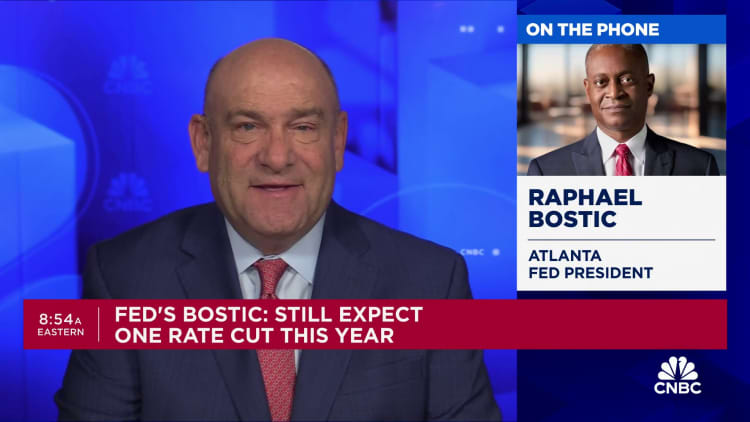
[ad_1]
U.S. President Joe Biden, delivers remarks on the U.S. economy and his administration’s effort to revive American manufacturing, during his visit in Flex LTD, a factory that makes solar energy microinverters, in West Columbia, South Carolina, U.S. July 6, 2023.
Jonathan Ernst | Reuters
President Joe Biden is fighting to convince inflation-weary voters that the U.S. economy is healthy.
“America has the best economy in the world,” he told NBC’s Today Show on Monday, laying out an argument that is central to his reelection campaign.
America’s economic standing in the world is becoming an early flashpoint on the campaign trail, where former President Donald Trump routinely depicts the United States as a commercial wasteland.
“We are a nation whose economy is collapsing into a cesspool of ruin,” Trump shouted at a Georgia rally last month, “whose supply chain is broken, whose stores are not stocked, whose deliveries are not coming.”
But the numbers paint a different picture, one more in line with Biden’s narrative of American economic dominance than Trump’s apocalyptic warnings.
U.S. gross domestic product was 2.5% in 2023, significantly outpacing that of other developed economies, according to a January report from the International Monetary Fund. The IMF projected that the U.S. will hold that lead in 2024, though it expects GDP to come down to 2.1%.
“The U.S. economy is leading the way for the global economy. It’s driving the global economic train,” Moody’s Chief Economist Mark Zandi told CNBC.
Even as interest rates spiked, the labor market has stayed strong. In March, U.S. private companies added 184,000 jobs, payrolls processing firm ADP reported on Wednesday, well ahead of the Dow Jones estimate of 150,000 jobs. It is the fastest employment growth the U.S. economy has seen since July 2023.
The stock market has also made record gains over the past several months and housing values have soared, though they have now begun to decline as inventory improves.
Besides sticky high prices that are projected to cool in the coming year, Zandi said that the fundamentals of the current U.S. economy are nearly ideal: “The economy is picture perfect. It’s hard to argue with it.”
‘Policy and luck’
The U.S. economy’s recent outperformance is the result of several factors.
“It’s both policy and luck,” said economist Joseph Gagnon of the Peterson Institute for International Economics, a Washington think tank.
In response to the economic quake of the pandemic, the U.S. government injected roughly $4 trillion of stimulus into the economy to support individual households and businesses.
US Speaker of the House Nancy Pelosi (C) and Representatives Kevin McCarthy (L) and Steny Hoyer show the bill to the press after the House passed a $2 trillion stimulus bill, on March 27, 2020, at the US Capitol in Washington, DC
Alex Edelman | AFP | Getty Images
“We had more fiscal stimulus than any other country and that is part of the reason why the U.S. has recovered from the Covid depression better than any other country,” said economist Josh Gottbaum, a former White House and Treasury Department official in both Republican and Democratic administrations, currently a guest scholar at the Brookings Institution.
America’s stimulus safety net came with a hefty price tag, leaving the U.S. with a much larger budget deficit than other countries. But it also kept the economy afloat, by providing a cushion so that companies did not have to execute mass layoffs that might have spiraled into a recession.
That labor market resilience has stuck. The unemployment rate has remained below 4% for the past two years, even as the Federal Reserve has sharply raised interest rates.
The U.S. economy’s position on the global stage is also a product of its resilience in the face of geopolitical crises, and the unique setup of the American financial system.
As Russia’s invasion of Ukraine disrupted global energy and food prices, for example, the U.S. was not hurt as much as areas like Europe and Japan, which rely more heavily on Russian energy and food imports,.
“That’s the luck part,” said Gagnon.
The U.S. economy’s resilience is also a result of its unique debt structures.
Townhomes are under construction on July 19, 2023 in Mundelein, Illinois.
Scott Olson | Getty Images
U.S. households were more insulated from spikes in global rates, because of the 30-year fixed-rate mortgage, which allowed households to lock in extremely low mortgage rates from the early days of the pandemic. That 30-year mortgage rate, which is mostly unique to the U.S. financial system, protected households as rates later heated up.
“Our banking system takes a lot of interest rate risk, but in the rest of the world, they shove it on to the household, on to businesses,” said Zandi. “That was really important this go around.”
Not ‘free and clear’ yet
Even as the U.S. economy stays ahead of the rest of the developed world, there is still room for setbacks in the recovery.
“I don’t think we can conclude that we’ve soft landed, that we’re free and clear,” said Zandi.
Though inflation has fallen sharply from its 2022 highs, it has ticked back up in the past several months.
For now, the Federal Reserve remains hawkish on interest rates, despite previous indications the central bank would issue three cuts this year.
“On inflation, it is too soon to say whether the recent readings represent more than just a bump,” Federal Reserve Chair Jerome Powell said Wednesday.

Atlanta Federal Reserve President Raphael Bostic now expects just one rate cut this year, likely towards the fourth quarter.
“The road is going to be bumpy,” Bostic said Wednesday in an interview on CNBC’s Squawk Box.
And while the path of the U.S. economy’s recovery is still uncertain, experts are optimistic.
“We’re basically on or above the track we were on before the pandemic hit,” said Gagnon, of the Peterson Institute. “So that’s pretty darn good.”
[ad_2]
Source link
